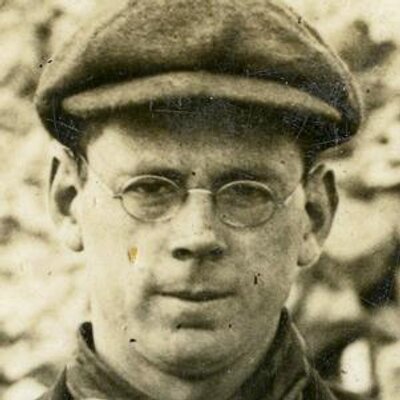“What must have galled them was that while we were reasonably civil, we were never prepared to do things in a military way. We never saluted anybody. We never stood to attention. Well, of course, that was a frightful crime in the eyes of the military authorities.”
http://www.whitefeatherdiaries.org.uk/sentenced-death

In the First World War, men who refused to sign up to the armed forces following the introduction of conscription in Britain, through the Military Service Act in January 1916, were labelled conscientious objectors.[i] These men varied in the extent to which they refused to contribute to the war effort: some men agreed to work in other sectors of the conflict, by being ambulance drivers or working in munitions factories, whereas others refused to contribute anything towards the war effort due to their personal commitment to pacifism. The latter group were often punished, and Howard Marten, a Quaker working as a bank clerk from London, was one of these men. He was sentenced to death in 1916 in a camp known as Cinder City near Boulogne, but this was changed to penal servitude for ten years, to be served in England, as a result of political pressure in Britain. He was then released in December 1917 after agreeing to work with the with the Friends War Victims Relief Committee in France.[ii]
What does Howard Marten’s experience teach us about peace?

Howard Marten’s experience is extremely powerful in showing how far some people will go to defend their personal commitment to peace. Marten, as a Quaker, was strongly anti-conflict. As a result, he refused to contribute to the war effort in any way, despite facing wage stoppages, twenty-eight days of field punishment (which often meant being tied to an artillery gun and left overnight) and even the death penalty.[iii] We might see this as a form of bravery or heroism – self-sacrifice for a cause – even though conscientious objectors at the time were often accused of being cowards and the opposite of cliched, military ideas of heroism.
Marten was clearly proud of his strength and resilience, and of the commitment also of his fellow Quakers and Conscientious Objectors. He wrote at one point: ‘it became clear that we weren’t people that could be bullied into it [fighting].’[iv] Despite outward pressure to succumb and join the ‘war effort’, Marten and his colleagues stayed loyal to their personal beliefs.
Some of this resilience came from within, but Marten clearly also drew strength from a sense of collective action. In another reflection, he wrote: ‘It was very curious. On that parade ground I felt that I was a different personality. I was part of something much bigger outside myself. I was part of something that I couldn’t explain. There was something mystical about it. It was very strange.’ Marten’s reference to mysticism here implies that his pacifist beliefs come from outside as well as within and connect him to a much greater force, impossible to fully describe. His moral position becomes a spiritual one, and the inner becomes outer, revealing pacifism to be not simply a personal viewpoint but a broader philosophy already out there in the ether.
Some of this was no doubt connected to Marten’s Quaker beliefs. One reason I decided to include his story in our peace museum is because it highlights the impact that identity, belief systems and religious positionality can have in shaping and articulating personal attitudes to peace. Another reason for including it is what it reveals about the complex relationship between an individual’s personal, moral position on peace and wider political peace-keeping/peace-making/security initiatives. Marten’s story is an example of grassroots campaigning against the system. Despite belonging to an unpopular minority, he continued to promote his pacifist ideas as a better alternative to the state’s demands that its citizens ‘fight’ for peace. But he faced accusations that his stance involved him letting others down, putting his country’s soldiers and the nation’s safety at risk by facilitating further conflict. Marten’s story raises important questions about the ‘rights’ and ‘wrongs’ of putting one’s personal commitment to pacifism and inner/moral peace above the demands of society and the state’s very different approaches to conflict resolution.
Marten’s ultimate decision to join the Friends War Victims Relief Committee in France suggests that his moral compass shifted over time – or at least, that he may have become more pragmatic in his anti-war stance. This reminds us that attitudes to war and peace can change as circumstances evolve.
What do you think?
- How does punishing pacifists/pacifism affect a society’s chance of achieving peace?
- Is moral peace purely individual, or is it intertwined into something larger?
- How do we draw a line between supporting the aims of a conflict but not engaging in it?
- Is pacifism always valid, no matter what the context?
- Can you think of other examples when pacifism has been criticised or punished, while ‘joining the war effort’ has been upheld as the best way to achieve ‘peace’?
If you enjoyed this item in our museum…
You might also like The Weight of a White Feather, ‘Om Shanti‘ and other items with the tag ‘Moral Peace‘.
Claire Percival, May 2022
[i] You can find out more about conscientious objectors here and here. The Library of the Religious Society of Friends in Britain has a long list of additional sources here.
[ii] You can read more about Marten’s life here: http://www.whitefeatherdiaries.org.uk/howard-marten.
[iii] https://www.bbc.co.uk/sounds/play/b07hgbj6.
[iv] http://www.whitefeatherdiaries.org.uk/sentenced-death.